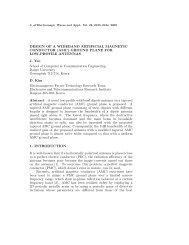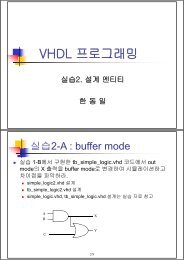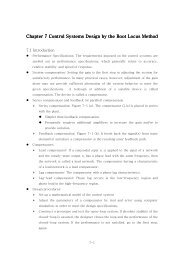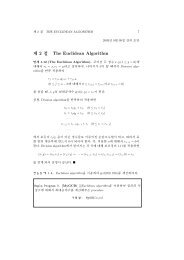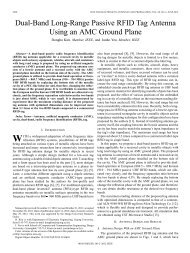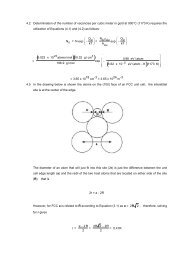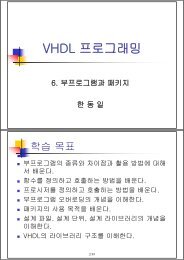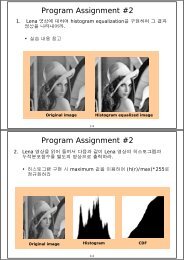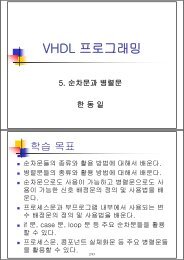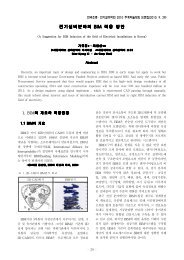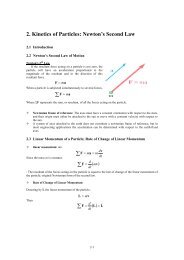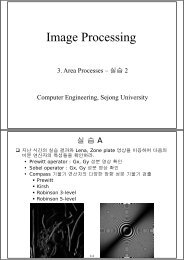Internal generation of waves for extended Boussinesq equations
Internal generation of waves for extended Boussinesq equations
Internal generation of waves for extended Boussinesq equations
You also want an ePaper? Increase the reach of your titles
YUMPU automatically turns print PDFs into web optimized ePapers that Google loves.
( )<br />
C. Lee et al.rCoastal Engineering 42 2001 155–162 157<br />
Eu<br />
q Ž uP= . uqg=h<br />
Et<br />
a½ ž / ž / 5<br />
za<br />
Eu Eu<br />
qz = =P q= =P h s0.<br />
2 Et Et<br />
Ž 2.<br />
In Eqs. Ž. 1 and Ž. 2 , h is the water surface elevation,<br />
u is the horizontal velocity vector at a certain<br />
elevation <strong>of</strong> zsz a, h is the mean water depth, g is<br />
the gravitational acceleration, = is the horizontal<br />
gradient operator, and asŽ z .<br />
arh 2 r2qzarh. In<br />
this study, asy0.4 is used which gives zarhs<br />
y0.55.<br />
Waves are generated internally by adding the<br />
value <strong>of</strong> h ) to the computed surface elevation h at<br />
the wave <strong>generation</strong> line at each time step. The value<br />
<strong>of</strong> h ) is given by:<br />
° I<br />
CDt<br />
2h cosu , mass transport<br />
) ~ D x<br />
h s , Ž 3.<br />
CeDt<br />
I<br />
¢ 2h cosu , energy transport<br />
D x<br />
where h I is the water surface elevation <strong>of</strong> incident<br />
<strong>waves</strong>, C and Ce<br />
are the phase and energy velocities<br />
<strong>of</strong> incident <strong>waves</strong>, respectively, u is the angle <strong>of</strong><br />
wave rays from the x-axis, D x is the grid size in the<br />
x-axis, and Dt is the time step. The wave <strong>generation</strong><br />
line is assumed to be parallel to the y-axis.<br />
The phase velocity and energy velocity <strong>of</strong> <strong>waves</strong><br />
can be obtained analytically using the geometric<br />
optics approach. In the case that water depths are<br />
constant and the nonlinear terms are ignored, differentiating<br />
Eq. Ž. 1 in space, differentiating equation<br />
Eq. Ž. 2 in time, and eliminating h from two resultant<br />
<strong>equations</strong> yield the following equation as,<br />
E 2 u<br />
ygh= =Pu Ž .<br />
Et 2<br />
ž /<br />
1<br />
y aq<br />
3<br />
Ž . 4<br />
3<br />
gh= =P = =Pu<br />
ž /<br />
E 2 u<br />
2<br />
qa h = =P s0. Ž 4<br />
2<br />
.<br />
Et<br />
When we consider the wave field along the direction<br />
<strong>of</strong> wave ray, i.e., s-direction, the wave field may<br />
be analyzed in one dimension. Then, the particle<br />
velocity u may be defined as,<br />
usAe ic , Ž 5.<br />
where A is the amplitude <strong>of</strong> the velocity and the<br />
phase function c has the following relations with<br />
the wave number k and angular frequency v as,<br />
Ec Ec<br />
ks , vsy . Ž 6.<br />
Es Et<br />
Substituting Eq. Ž. 5 into Eq. Ž. 4 and rearranging<br />
the real part <strong>of</strong> the resultant equation to the order <strong>of</strong><br />
OŽ.<br />
1 yield the phase velocity C as:<br />
) ž /<br />
2<br />
1<br />
2<br />
1y aq Ž kh<br />
v<br />
.<br />
3<br />
Cs s gh . Ž 7.<br />
k<br />
1ya Ž kh.<br />
Substituting Eq. Ž. 5 into Eq. Ž. 4 , rearranging the<br />
imaginary part <strong>of</strong> the resultant equation to the order<br />
<strong>of</strong> OŽ E ArEt, E ArEs ., and further multiplying by A<br />
yield the transport equation <strong>for</strong> wave energy given<br />
as,<br />
E A 2 E A 2<br />
qCe<br />
s0, Ž 8.<br />
Et Es<br />
where the energy velocity Ce<br />
is given by:<br />
2<br />
Ž kh.<br />
Ce sC 1y .<br />
1<br />
2 2<br />
3½1yž aq<br />
/ Ž kh. 51ya Ž kh.<br />
4<br />
3<br />
Ž 9.<br />
It should be noted that the energy velocity Ce<br />
is<br />
the same as the group velocity Cg<br />
sEvrEk obtained<br />
by Nwogu Ž 1993 ..<br />
3. Numerical experiment<br />
Numerical experiments are conducted in horizontally<br />
one-dimensional cases. The governing <strong>equations</strong><br />
are discretized in time using the predictor-cor-



